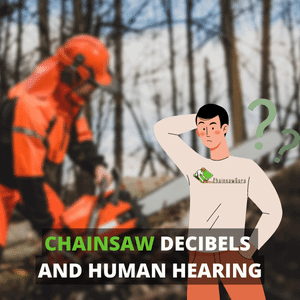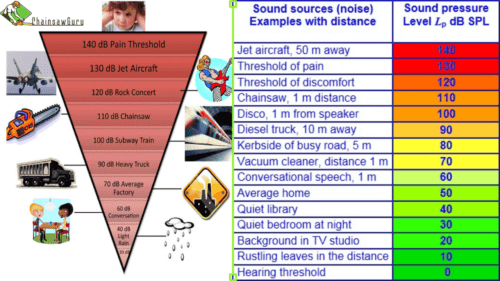
And thus, finding the exact chainsaw decibels can lead you to save yourself and your neighbors.
However, giving you a figure value, the chainsaw sound in decibels is 106 – 120 dB. With that, you can get an idea of how dangerous a chainsaw sound can be.
Moreover, in today’s blog, we have answered how many decibels is a chainsaw in detail and shared information you need to know before getting into the chainsaw business.
Stick around and find some shocking facts about the chainsaw as well. Before that, let’s have a quick shot of our hearing process.
Chainsaw Decibels and Human Hearing
Reminding old school lessons, if you can remember how our outer ear directs sounds to the brain through the eardrum, ossicles (tiny bones), and cochlea. The cochlea’s fluid then send electrical signals to the brain via the hearing nerve to identify the sound.
All this process occurs within seconds, and we perceive sounds accordingly. But don’t consider this process a go-to way for every other sound –because limitations come with the complexity.
Consequently, human ears are developed to adapt to a specific amount of decibels. For instance, we can’t hear sounds that are below 0 dB. Thus, there are certain sound levels humans can tolerate.
Human Sound (dB) Tolerating Chart
Decibels Range | Human Sounds Perception | Examples |
|---|---|---|
0 dB | No Hearing | Dog's whistle |
10 -70 dB | Acceptable and Safe | People's Conversations |
80 - 90 dB | Acceptable but Damaging | Busy streets and roads |
100 - 110 | Not acceptable and damaging | Steel mill, Turbofan Aircraft, Chainsaw |
120 and above | Extremely harmful | Noise of high profile tools |
Now, let’s see how chainsaw decibels impact human hearing:
Chainsaw Sound Production Level: Shocking Facts
The chainsaw has a visceral sound that is extremely nerve taking. Chainsaw noise can easily be compared to helicopter sound. However, considered the most demanding tool, chainsaws are used everywhere for cutting trees and pruning.
Thus, its sound production level might exceed, and if experienced for a longer period, it can cause serious trouble. As said earlier, chainsaw decibels are around 106 – 120. And after evaluating the human sound tolerance chart, it’s pretty clear how a useful tool can threaten normal human functioning.
Chainsaw Hazards
|
Moreover, a handyman experience noise exposure beyond standard time. Therefore, using protections for hearing and reduced noise exposure is necessary. Also, identifying the right equipment, maintenance, and management can help you keep your ears safe and sound. (see next section for more information)
You can also check the chainsaw’s effects on the human body after experiencing excessive vibrations.
Experience Safe Sounds: Manage Your Chainsaw
In order to prevent high noise output from your home use chainsaw, you can try the following things to maintain and manage your machine;
- Maintain your chainsaw by keeping the oil flow and sharp chain (fixed at the right tension).
- Tune your engine and check if it runs smoothly throughout the cutting process or not. (It shouldn’t work only at increased RPM (otherwise, get a carburetor job).
- Keep the air filter clean and prevent it from getting dusty. (Change the air filter after the ending or before the starting of every new cutting season).
- Check baffle condition to ensure consistent fuel flow to the chainsaw chain and bar. (If the baffles are rusty or have a hole, they will produce more noise)
- Fix or bolt the muffler to the engine block firmly and check if there are any holes, rust, or splits. (Clean or replace the muffler if you find rust or holes, respectively).
Credits: RPG Net Forums
New England Soundproofing
Tips to Control Your Chainsaw Noise
After analysis of your chainsaw, you can try the mentioned tips to get a better working experience;
- You can reconsider the chainsaw use (for instance, use an electric chainsaw that is less noisy and give quite a similar cutting experience).
- You can also use handsaws, shears, and reciprocating saws (electrical, battery-powered) to prune your trees and logs.
- Don’t utilize your machine more than its capacity and ensure the cutting of trees without going up to standard chainsaw rev.
- Switch off or power off your chainsaw after specific intervals to keep it cool and effective, which results in less noise.
Protect Your Ears from 120 dB Chainsaw in 2025
Finally, it’s time to keep yourself safe by using the essential protective things before starting to cut trees with your chainsaw. Also, it would help if you practiced the following advice to overcome the chainsaw noise consequences.
- Using ear protection is the easiest way to reduce chainsaw decibels. Therefore, choose the right pair of earmuffs that reduces dB to 80 – 85 dB (tolerable).
- Instead of working constantly, take short breaks after every half an hour and avoid high-potential chainsaw sounds.
- Avoid contacting other co-workers during the cutting process and save yourself from experiencing consistent high noises.
Recap to Ensure Your Protection
|
FAQs: Find Answers to Your Queries
How many decibels is a GreenWorks chainsaw?
The range of decibels depends on the model of the GreenWorks chainsaw that you will opt for. For example, Green Works Pro 80 has 86.8 tolerable decibels.
How many decibels is a gas chainsaw?
Gas chainsaws are usually more noise-producing than other chainsaws. A gas chainsaw’s estimated decibel value of sound is 110 – 120 dB.
How many decibels is a battery-powered chainsaw?
Battery-powered chainsaws produce less noise compared to gas chainsaws. However, the working potential of this chainsaw is quite reduced, and battery-operated chainsaws cannot work as effectively as gas-powered chainsaws. But, the only plus point is that battery-powered chainsaws have reduced sound decibels up to 10 – 30 dB more than gas chainsaws.
Wrapping Up: How Many Decibels is a Chainsaw in 2025?
Being a life-threatening tool with 106 – 120 dB, a chainsaw requires your attention and careful use. So, don’t forget to use your protective gear including chainsaw chaps and gloves every time you work. And practice all the mentioned things in the article to make your work easy and less horrifying.
Protect your ears, or else the chainsaw will (you know the rest). Have comfy woody days…
- How Thick of a Branch Can a Pole Saw Cut? - July 8, 2025
- How Many Watts Does a Pole Saw Use? - July 4, 2025
- How Long Is a Pole Saw? - July 3, 2025

